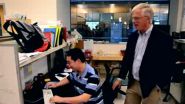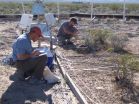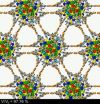(Press-News.org) SAN DIEGO, CA (April 6, 2014)—Tumor cells are picky about where they live. In the wrong environment, they fail to reach their potential. But put those same cells on the right bit of real estate, and they grow like mad. Researchers at Fox Chase Cancer Center found renal cancer cells planted in a supportive environment proliferate with the help of an enzyme usually only seen in the brain.
The enzyme, a specific isoform of a rather common kinase, may eventually become a target for cancer therapy as kinases constitute reasonably targetable enzymes, said Edna Cukierman, PhD, Associate Professor at Fox Chase, whose research focuses on the interactions between tumors and the microenvironments where they live. The research will be presented on April 6 at the AACR Annual Meeting 2014.
The microenvironment that Cukierman uses to help determine a cancer's fate is called the extracellular matrix (ECM), a network of structural molecules localized outside the cell that play a role in regulating numerous cell behaviors, for instance known by sending signals to promote wound healing or embryonic growth and development. Cukierman employs a three-dimensional model she developed to watch what happens when a tumor-altered matrix encourages cancer growth.
In cooperation with surgeons at Fox Chase, Cukierman uses freshly donated renal cell carcinoma tissue and extracts cells called fibroblasts from kidney tissue well outside of the tumor growth margins. She collects other fibroblasts from tissue within the cancer growth area of the same patient. The fibroblasts, which naturally secrete the mesenchymal extra cellular matrix, are used to create two sets of three-dimensional scaffolding per patient, one matrix from pro-growth fibroblast and a second from fibroblasts that keep tumor growth under control.
The researchers put renal cancer cells from established cell lines into both matrices. Those put in the tumor-promoting matrix proliferated quickly, with rapid metabolism and invasive capabilities. Identical cancer cells put in the normal matrix from the same patient grew slowly, failed to invade and when researchers withdrew external nutrients, the cells died. After the cancer cells were allowed to grow, the researchers looked at how the protein composition of the proliferating cancer cells differed from the lazy cancer cells by performing an RNA expression analysis. The analysis revealed that cancer cells in the pro-growth matrix had higher levels of RNA for a kinase normally found in neurons in the brain. A kinase is an enzyme capable of attaching phosphate groups to other molecules and many kinases constitute excellent targets used in cancer treatments.
When researchers inhibited the kinase, cancer cell division and spread halted, suggesting that the kinase was not just a cancer marker, but played an important role in cancer growth.
"So we were able to validate that this interesting kinase, which has no business being in the kidney, is functionally responsible for responding to cues that the matrix is transmitting," Cukierman said. When her team examined the tumors of the patients who donated the fibroblasts, they found elevated levels of the same kinase isoform.
"This is really exciting because we know that we may be able to try, at some distant point in the future, ways to inhibit this enzyme. There's a good chance it will be rather specific to cancer. And since this kinase is otherwise found merely in the brain, we would try to make a drug that didn't cross the blood-brain barrier and create too many side effects," she said.
Further, she hopes that similar approaches could help her find the key to converting tumor-promoting matrix into a tumor-confining substrate. "But right now, we're just looking at the matrix-induced tumoral mechanisms, and trying to understand how come this enzyme is up-regulated in cancer cells that are in the tumor-associated but not in the normal microenvironment."
INFORMATION:
Co-authors on the study include J. Franco-Barraza, V. Gupta, N. Shah, E. Dulaimi, Y. Zhou, K. Devarajan, Q. Cai, K.R. Alpaugh, and R.G. Uzzo from Fox Chase.
Fox Chase Cancer Center, part of the Temple University Health System, is one of the leading cancer research and treatment centers in the United States. Founded in 1904 in Philadelphia as one of the nation's first cancer hospitals, Fox Chase was also among the first institutions to be designated a National Cancer Institute Comprehensive Cancer Center in 1974. Fox Chase researchers have won the highest awards in their fields, including two Nobel Prizes. Fox Chase physicians are also routinely recognized in national rankings, and the Center's nursing program has received the Magnet status for excellence four consecutive times. Today, Fox Chase conducts a broad array of nationally competitive basic, translational, and clinical research, with special programs in cancer prevention, detection, survivorship, and community outreach. For more information, visit Fox Chase's Web site at http://www.foxchase.org or call 1-888-FOX CHASE or (1-888-369-2427).
Researchers find that renal cancer cells thrive when put in the right environment and supported by a specific enzyme
The enzyme, usually only seen in the brain, could become a target for cancer therapy
2014-04-06
ELSE PRESS RELEASES FROM THIS DATE:
Scripps Research Institute scientists provide new grasp of soft touch
2014-04-06
LA JOLLA, CA—April 6, 2014—A study led by scientists at The Scripps Research Institute (TSRI) has helped solve a long-standing mystery about the sense of touch.
The "gentle touch" sensations that convey the stroke of a finger, the fine texture of something grasped and the light pressure of a breeze on the skin are brought to us by nerves that often terminate against special skin cells called Merkel cells. These skin cells' role in touch sensation has long been debated in the scientific community. The new study, however, suggests a dual-sensor system involving the Merkel ...
Amino acid fingerprints revealed in new study
2014-04-06
VIDEO:
This animation shows the basic process of sequencing amino acids in a nanopore, using the technique of recognition tunneling.
Click here for more information.
Some three billion base pairs make up the human genome—the floor plan of life. In 2003, the Human Genome Project announced the successful decryption of this code, a tour de force that continues to supply a stream of insights relevant to human health and disease.
Nevertheless, the primary actors in virtually all ...
Scientists find potential drug targets in deadly pediatric brain tumors
2014-04-06
BOSTON, MA (April 6, 2014) -- Researchers studying a rare, always fatal brain tumor in children have found several molecular alterations that drive the cancer, according to a new study from scientists at Dana-Farber/Boston Children's Cancer and Blood Disorders Center and McGill University. The findings identify potential new targets for drug treatments.
The new research could help physicians choose targeted agents with a better chance of combating pediatric high-grade astrocytomas, which are extremely difficult to treat with radiation and surgery. The tumors have resisted ...
Field study shows why food quality will suffer with rising CO2
2014-04-06
For the first time, a field test has demonstrated that elevated levels of carbon dioxide inhibit plants' assimilation of nitrate into proteins, indicating that the nutritional quality of food crops is at risk as climate change intensifies.
Findings from this wheat field-test study, led by a UC Davis plant scientist, will be reported online April 6 in the journal Nature Climate Change.
"Food quality is declining under the rising levels of atmospheric carbon dioxide that we are experiencing," said lead author Arnold Bloom, a professor in the Department of Plant Sciences.
"Several ...
Researchers find arid areas absorb unexpected amounts of atmospheric carbon
2014-04-06
PULLMAN, Wash.—Researchers led by a Washington State University biologist have found that arid areas, among the biggest ecosystems on the planet, take up an unexpectedly large amount of carbon as levels of carbon dioxide increase in the atmosphere. The findings give scientists a better handle on the earth's carbon budget—how much carbon remains in the atmosphere as CO2, contributing to global warming, and how much gets stored in the land or ocean in other carbon-containing forms.
"It has pointed out the importance of these arid ecosystems," said R. Dave Evans, a WSU professor ...
Friedreich's ataxia -- an effective gene therapy in an animal model
2014-04-06
The transfer, via a viral vector, of a normal copy of the gene deficient in patients, allowed to fully and very rapidly cure the heart disease in mice. These findings are published in Nature Medicine on 6 April, 2014.
Friedreich's ataxia is a severe, rare hereditary disorder which combines progressive neuro-degeneration, impaired heart function and an increased risk of diabetes. The condition affects one in every 50,000 birth. There is currently no effective treatment for this disease. In most cases, Friedreich's ataxia starts in adolescence with impaired balance and ...
Smoking visibility mapped for the first time
2014-04-06
The visibility of smoking in city streets has for the first time anywhere been mapped, in new research from the University of Otago, Wellington, New Zealand.
The research found that up to 116 smokers outside bars/cafés could be seen from any one location in the outdoor public areas of downtown Wellington (e.g. on a footpath). Of 2600 people observed in the outdoor areas of bars and cafés, 16% were smoking, with a higher proportion than this in evenings.
Data from observations across the downtown area were mapped by the researchers, producing a record of the street ...
Blood test could provide rapid, accurate method of detecting solid cancers
2014-04-06
STANFORD, Calif. — A blood sample could one day be enough to diagnose many types of solid cancers, or to monitor the amount of cancer in a patient's body and responses to treatment. Previous versions of the approach, which relies on monitoring levels of tumor DNA circulating in the blood, have required cumbersome and time-consuming steps to customize it to each patient or have not been sufficiently sensitive.
Now, researchers at the Stanford University School of Medicine have devised a way to quickly bring the technique to the clinic. Their approach, which should be broadly ...
Self-assembled superlattices create molecular machines with 'hinges' and 'gears'
2014-04-06
VIDEO:
This video shows the motion of nanoparticles in neighboring layers of the superlattice as pressure is applied.
Click here for more information.
A combined computational and experimental study of self-assembled silver-based structures known as superlattices has revealed an unusual and unexpected behavior: arrays of gear-like molecular-scale machines that rotate in unison when pressure is applied to them.
Computational and experimental studies show that the superlattice ...
Groundbreaking optical device could enhance optical information processing, computers
2014-04-06
At St. Paul's Cathedral in London, a section of the dome called the Whispering Gallery makes a whisper audible from the other side of the dome as a result of the way sound waves travel around the curved surface. Researchers at Washington University in St. Louis have used the same phenomenon to build an optical device that may lead to new and more powerful computers that run faster and cooler.
Lan Yang, PhD, associate professor of electrical and systems engineering, and her collaborators have developed an essential component of these new computers that would run on light. ...
LAST 30 PRESS RELEASES:
Heart-brain connection: international study reveals the role of the vagus nerve in keeping the heart young
Researchers identify Rb1 as a predictive biomarker for a new therapeutic strategy in some breast cancers
Survey reveals ethical gaps slowing AI adoption in pediatric surgery
Stimulant ADHD medications work differently than thought
AI overestimates how smart people are, according to HSE economists
HSE researchers create genome-wide map of quadruplexes
Scientists boost cell "powerhouses" to burn more calories
Automatic label checking: The missing step in making reliable medical AI
Low daily alcohol intake linked to 50% heightened mouth cancer risk in India
American Meteorological Society announces Rick Spinrad as 2026 President-Elect
Biomass-based carbon capture spotlighted in newly released global climate webinar recording
Illuminating invisible nano pollutants: advanced bioimaging tracks the full journey of emerging nanoscale contaminants in living systems
How does age affect recovery from spinal cord injury?
Novel AI tool offers prognosis for patients with head and neck cancer
Fathers’ microplastic exposure tied to their children’s metabolic problems
Research validates laboratory model for studying high-grade serous ovarian cancer
SIR 2026 delivers transformative breakthroughs in minimally invasive medicine to improve patient care
Stem Cell Reports most downloaded papers of 2025 highlight the breadth and impact of stem cell research
Oxford-led study estimates NHS spends around 3% of its primary and secondary care budget on the health impacts of heat and cold in England
A researcher’s long quest leads to a smart composite breakthrough
Urban wild bees act as “microbial sensors” of city health.
New study finds where you live affects recovery after a hip fracture
Forecasting the impact of fully automated vehicle adoption on US road traffic injuries
Alcohol-related hospitalizations from 2016 to 2022
Semaglutide and hospitalizations in patients with obesity and established cardiovascular disease
Researchers ‘listen in’ to embryo-mother interactions during implantation using a culture system replicating the womb lining
How changing your diet could help save the world
How to make AI truly scalable and reliable for real-time traffic assignment?
Beyond fragmented markets: A new framework for efficient and stable ride-pooling
Can shape priors make road perception more reliable for autonomous driving?
[Press-News.org] Researchers find that renal cancer cells thrive when put in the right environment and supported by a specific enzymeThe enzyme, usually only seen in the brain, could become a target for cancer therapy







